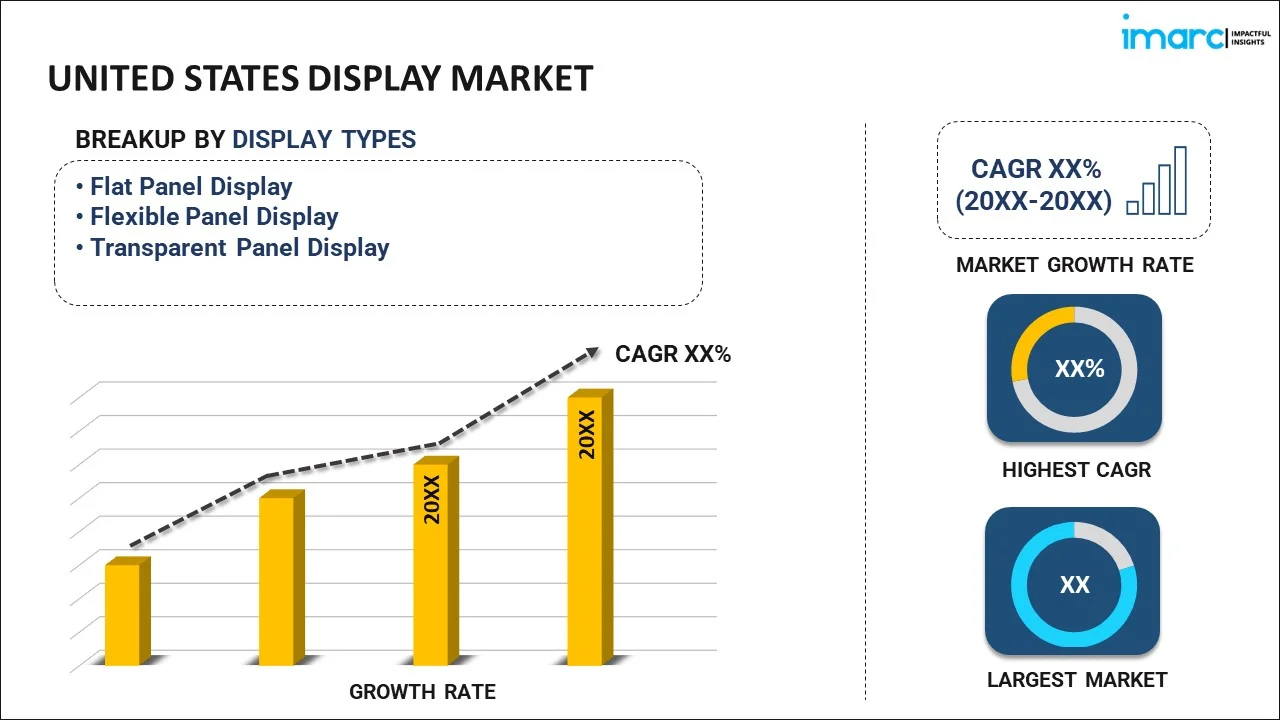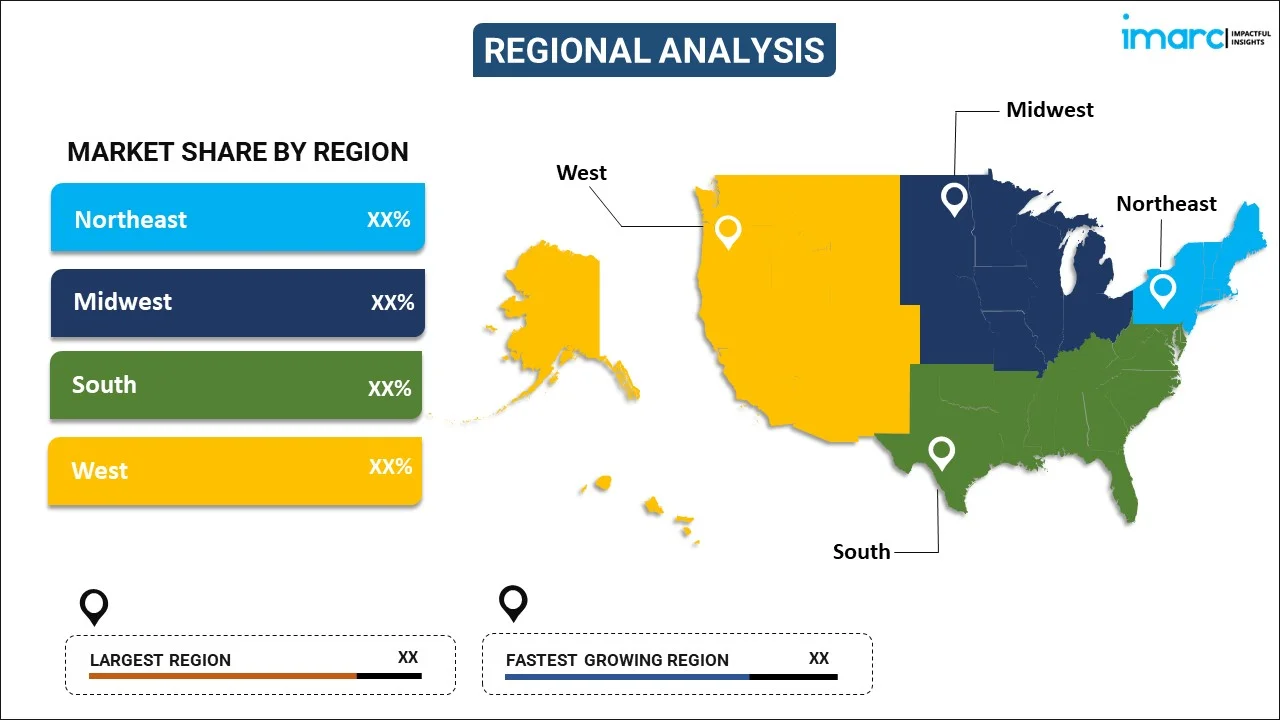
United States Display Market Report by Display Type (Flat Panel Display, Flexible Panel Display, Transparent Panel Display), Technology (OLED, Quantum Dot, LED, LCD, E-paper, and Others), Application (Smartphone and Tablet, Smart Wearable, Television and Digital Signage, PC and Laptop, Vehicle Display, and Others), Industry Vertical (BFSI, Retail, Healthcare, Consumer Electronics, Military and Defense, Automotive, and Others), and Region 2025-2033
Market Overview:
The United States display market size reached USD 42.0 Billion in 2024. Looking forward, IMARC Group expects the market to reach USD 54.2 Billion by 2033, exhibiting a growth rate (CAGR) of 2.76% during 2025-2033. The increasing adoption of advanced display technologies across various industries, the proliferation of smartphones, tablets, wearables, and smart home devices, and the robust economic growth and increased disposable income levels are some of the key factors driving the market.
|
Report Attribute
|
Key Statistics
|
|---|---|
|
Base Year
|
2024
|
|
Forecast Years
|
2025-2033
|
|
Historical Years
|
2019-2024
|
|
Market Size in 2024
|
USD 42.0 Billion |
|
Market Forecast in 2033
|
USD 54.2 Billion |
| Market Growth Rate 2025-2033 | 2.76% |
Display refers to the visual output or presentation of information, data, or images on a screen or surface for human observation. It is a critical component of various electronic devices, such as computers, smartphones, televisions, and digital signage, as it allows users to interact with and perceive information in a meaningful way. Displays come in various technologies, including Liquid Crystal Display (LCD), Light Emitting Diode (LED), and Organic Light Emitting Diode (OLED). Higher resolution displays offer crisper and more detailed images, while accurate color reproduction ensures lifelike visuals. A faster refresh rate provides smoother motion, which is crucial for activities, including gaming and video playback. Moreover, brightness plays a vital role in readability and usability under different lighting conditions. With the advent of touchscreen technology, displays have become more interactive, enabling users to directly interact with the displayed content using gestures and touches.
United States Display Market Trends:
The increasing adoption of advanced display technologies across various industries is driving the market in the United States. As businesses seek to enhance customer engagement and improve user experiences, they are investing heavily in innovative displays such as OLEDs, LCDs and MicroLEDs. These displays offer higher resolution, better color accuracy, and faster response times, catering to the demands of modern consumers and businesses alike. Furthermore, the rising demand for large screen displays in the entertainment and gaming sectors is providing a boost to the market. With the growing popularity of high-definition content, virtual reality, and gaming experiences, consumers are seeking larger, more immersive displays. As a result, several manufacturers are developing larger and more advanced display panels to meet this demand, impelling substantial growth in the market. Moreover, the increase in smart devices and the Internet of Things (IoT) has significantly influenced the display market. The proliferation of smartphones, tablets, wearables, and smart home devices has created a massive demand for smaller, energy-efficient displays with touch capabilities. These devices are increasingly becoming integral to everyday life, supporting continuous innovation in the display industry to cater to their evolving needs. Besides, the ongoing digital transformation across various sectors has led to increased adoption of display technologies in retail, healthcare, automotive, and industrial applications. Businesses are leveraging displays to create interactive and informative experiences for their customers, patients, and employees, thereby impelling the demand for versatile and specialized display solutions. Additionally, the United States robust economic growth and increased disposable income levels have fuelled consumer spending on electronic devices, including TVs, monitors, and laptops. As consumers seek enhanced visual experiences and seamless connectivity, they are willing to invest in high-quality displays with cutting-edge features, further creating a positive market outlook.
United States Display Market Segmentation:
IMARC Group provides an analysis of the key trends in each segment of the United States display market report, along with forecasts at the country level for 2025-2033. Our report has categorized the market based on display type, technology, application, and industry vertical.
Display Type Insights:

- Flat Panel Display
- Flexible Panel Display
- Transparent Panel Display
The report has provided a detailed breakup and analysis of the United States display market based on the display type. This includes flat panel display, flexible panel display, and transparent panel display.
Technology Insights:
- OLED
- Quantum Dot
- LED
- LCD
- E-paper
- Others
The report has provided a detailed breakup and analysis of the United States display market based on the technology. This includes OLED, quantum dot, LED, LCD, e-paper, and others.
Application Insights:
- Smartphone and Tablet
- Smart Wearable
- Television and Digital Signage
- PC and Laptop
- Vehicle Display
- Others
A detailed breakup and analysis of the United States display market based on the application has also been provided in the report. This includes smartphone and tablet, smart wearable, television and digital signage, pc and laptop, vehicle display, and others.
Industry Vertical Insights:
- BFSI
- Retail
- Healthcare
- Consumer Electronics
- Military and Defense
- Automotive
- Others
A detailed breakup and analysis of the United States display market based on the industry vertical has also been provided in the report. This includes BFSI, retail, healthcare, consumer electronics, military and defense, automotive, and others.
Regional Insights:

- Northeast
- Midwest
- South
- West
The report has also provided a comprehensive analysis of all the major regional markets, which include Northeast, Midwest, South, and West.
Competitive Landscape:
The report has also provided a comprehensive analysis of the competitive landscape in the market. Competitive analysis such as market structure, key player positioning, top winning strategies, competitive dashboard, and company evaluation quadrant has been covered in the report. Also, detailed profiles of all major companies have been provided.
Report Coverage:
| Report Features | Details |
|---|---|
| Base Year of the Analysis | 2024 |
| Historical Period | 2019-2024 |
| Forecast Period | 2025-2033 |
| Units | Billion USD |
| Scope of the Report | Exploration of Historical and Forecast Trends, Industry Catalysts and Challenges, Segment-Wise Historical and Predictive Market Assessment:
|
| Display Types Covered | Flat Panel Display, Flexible Panel Display, Transparent Panel Display |
| Technologies Covered | OLED, Quantum Dot, LED, LCD, E-Paper, Others |
| Applications Covered | Smartphone and Tablet, Smart Wearable, Television and Digital Signage, PC and Laptop, Vehicle Display, Others |
| Industry Verticals Covered | BFSI, Retail, Healthcare, Consumer Electronics, Military and Defense, Automotive, Others |
| Regions Covered | Northeast, Midwest, South, West |
| Customization Scope | 10% Free Customization |
| Post-Sale Analyst Support | 10-12 Weeks |
| Delivery Format | PDF and Excel through Email (We can also provide the editable version of the report in PPT/Word format on special request) |
Key Questions Answered in This Report:
- How has the United States display market performed so far and how will it perform in the coming years?
- What has been the impact of COVID-19 on the United States display market?
- What is the breakup of the United States display market on the basis of display type?
- What is the breakup of the United States display market on the basis of technology?
- What is the breakup of the United States display market on the basis of application?
- What is the breakup of the United States display market on the basis of industry vertical?
- What are the various stages in the value chain of the United States display market?
- What are the key driving factors and challenges in the United States display market?
- What is the structure of the United States display market and who are the key players?
- What is the degree of competition in the United States display market?
Key Benefits for Stakeholders:
- IMARC’s report offers a comprehensive quantitative analysis of various market segments, historical and current market trends, market forecasts, and dynamics of the United States display market from 2019-2033.
- The research study provides the latest information on the market drivers, challenges, and opportunities in the United States display market.
- Porter's five forces analysis assist stakeholders in assessing the impact of new entrants, competitive rivalry, supplier power, buyer power, and the threat of substitution. It helps stakeholders to analyze the level of competition within the United States display industry and its attractiveness.
- Competitive landscape allows stakeholders to understand their competitive environment and provides an insight into the current positions of key players in the market.
Need more help?
- Speak to our experienced analysts for insights on the current market scenarios.
- Include additional segments and countries to customize the report as per your requirement.
- Gain an unparalleled competitive advantage in your domain by understanding how to utilize the report and positively impacting your operations and revenue.
- For further assistance, please connect with our analysts.
 Inquire Before Buying
Inquire Before Buying
 Speak to an Analyst
Speak to an Analyst
 Request Brochure
Request Brochure
 Request Customization
Request Customization




.webp)




.webp)












